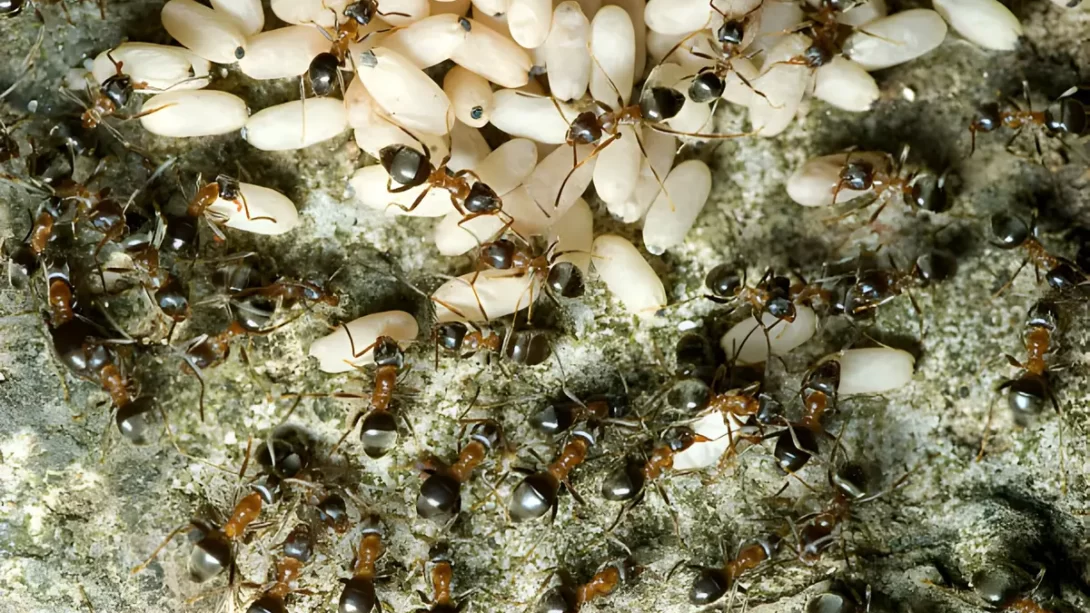Ants are one of the most common and fascinating insects, known for their complex social structures and efficient colony management. A crucial aspect of their life cycle involves the production and care of eggs, which ensure the continuation and growth of the colony. This article explores the appearance of ant eggs and their vital role within the ant community.
Ants and Their Colonies
Ants belong to the family Formicidae and are characterized by their highly organized colony structure. Each colony typically consists of the queen, the only fertile female responsible for laying eggs; males, whose primary role is to mate with the queen; and worker ants, which are sterile females that carry out various tasks including foraging, colony maintenance, and caring for the eggs. The queen’s sole purpose is to lay eggs, ensuring the survival and expansion of the colony.
The Ant Life Cycle
The life cycle of an ant is a fascinating process that includes several stages: egg, larva, pupa, and adult. This cycle begins with the egg stage. The eggs are laid by the queen and are the first stage in the development of new ants. After the eggs hatch, they develop into larvae, which are then nurtured and fed by the worker ants. Once the larvae have grown sufficiently, they enter the pupal stage, eventually emerging as adult ants. The egg stage is critical, as it represents the future generation of the colony and dictates its potential for growth and survival.
Characteristics of Ant Eggs
Ant eggs are typically oval-shaped and have a smooth, shiny surface. They are very small, usually about 0.5 to 1 millimeter in length, making them difficult to see with the naked eye. The color of ant eggs can vary but is generally a translucent white or cream color. It’s important to distinguish ant eggs from larvae and pupae, which are larger in size and have different shapes and textures. Larvae are generally worm-like and larger, while pupae resemble adult ants but are often enclosed in a cocoon-like structure in species that undergo complete metamorphosis.
Locating Ant Eggs
Ant eggs are typically found deep within the ant colony, often in specialized chambers dedicated to rearing and protecting the young. These chambers, located underground or inside the nest structure, provide a safe and controlled environment essential for the eggs’ development. Worker ants are responsible for tending to the eggs, which involves regularly moving them to regulate temperature and humidity. This careful management ensures the optimal conditions for the eggs to hatch into healthy larvae.
Identifying Ant Eggs in Nature
Identifying ant eggs in natural settings or around homes can be challenging due to their small size. However, if you come across a disrupted ant nest, you may notice tiny, oval-shaped objects clustered together – these are likely to be ant eggs. When observing a nest, it’s common to see worker ants quickly mobilizing to move the eggs to safety. It’s crucial to differentiate ant eggs from those of other insects. Ant eggs are distinct in their uniform oval shape and smooth texture, in contrast to the more varied shapes and textures of other insect eggs.
Importance of Ant Eggs in the Ecosystem
Ant eggs play a significant role in the ecosystem, both within the ant colony and in the broader environmental context. Within the colony, they represent the next generation of workers, soldiers, and reproductive ants, essential for the colony’s survival and prosperity. Ecologically, the presence of ant eggs indicates a healthy and functioning ant population, which contributes to various ecological processes such as soil aeration, seed dispersion, and the cycling of nutrients. Ant colonies, through their activities including caring for eggs and raising young, can impact their surrounding environment in meaningful ways.
Monitoring and Managing Ant Populations
While ant eggs are crucial for the survival of ant colonies, their presence in or near human dwellings can sometimes be a concern. Monitoring ant populations and their breeding sites can help manage their numbers, especially in cases of invasive ant species. Simple measures like sealing entry points, maintaining cleanliness to avoid attracting ants, and managing outdoor vegetation can help control ant infestations. However, it’s important to approach ant control responsibly, considering the ecological benefits ants provide.
Ethical Considerations and Ant Conservation
Ants, including their eggs, play a vital role in many ecosystems, serving as bioindicators of environmental health. It’s essential to balance ant control efforts with ethical considerations and the need for conservation. In some cases, ant populations may be threatened or endangered, making it crucial to protect their habitats and life cycles. Understanding and respecting the ecological role of ants and their eggs can lead to more informed and sustainable practices in both urban and natural environments.
Conclusion
In conclusion, ant eggs are a fascinating and integral part of the ant colony’s life cycle, playing a vital role in the growth and sustainability of the colony. These small, oval-shaped eggs are meticulously cared for by worker ants, reflecting the highly organized and cooperative nature of ant societies. Recognizing the importance of ant eggs in both the colony and the wider ecosystem underscores the need for a balanced approach to ant management and conservation. By appreciating the complexity of ant life cycles, we gain a deeper understanding of these remarkable insects and their role in our world.



